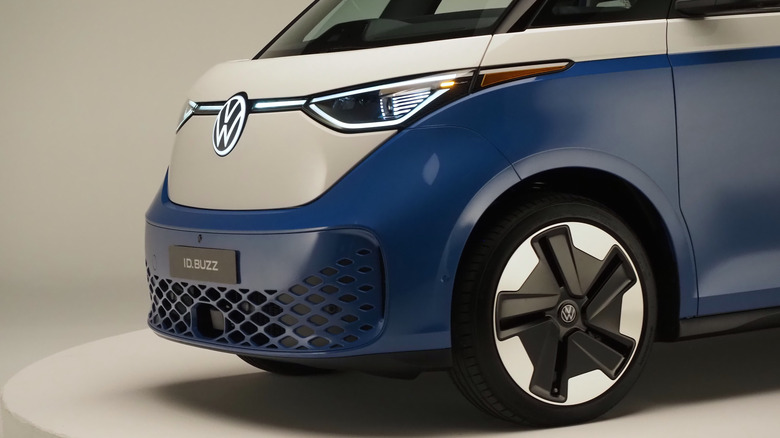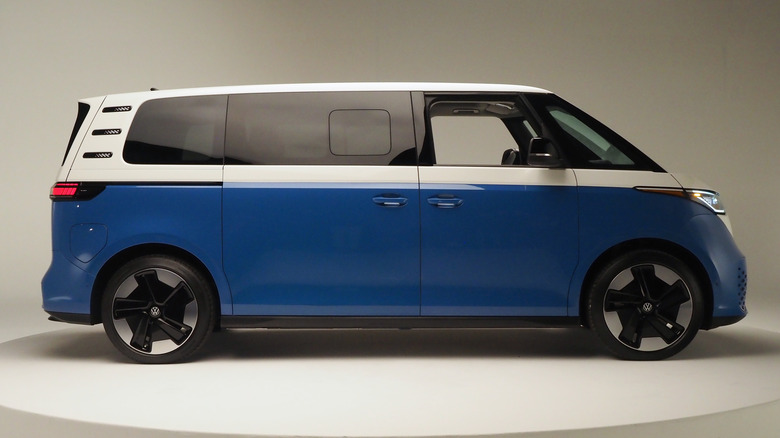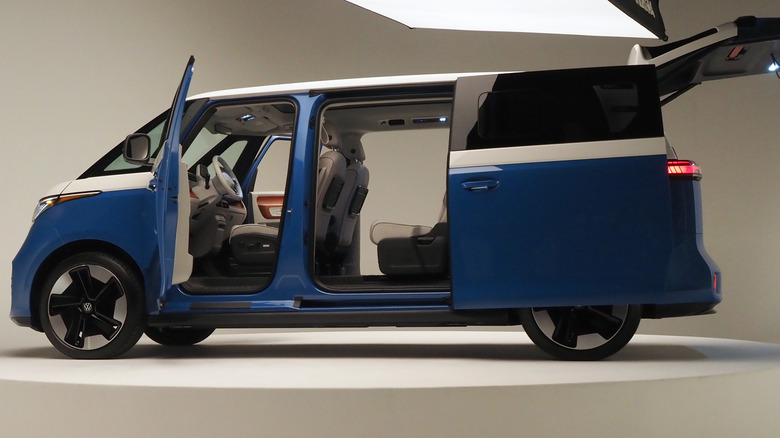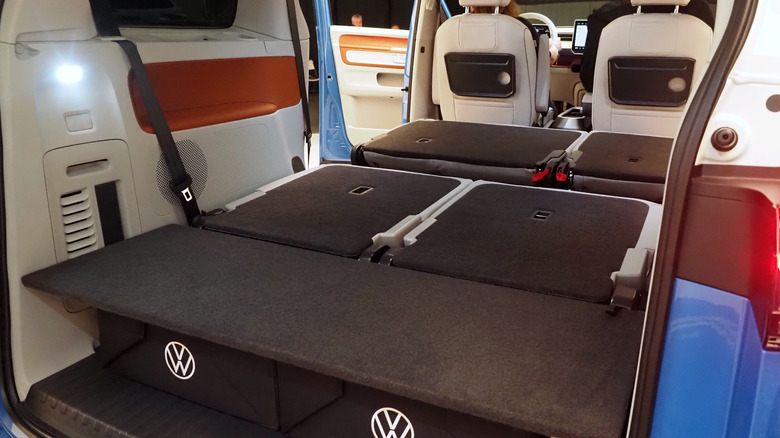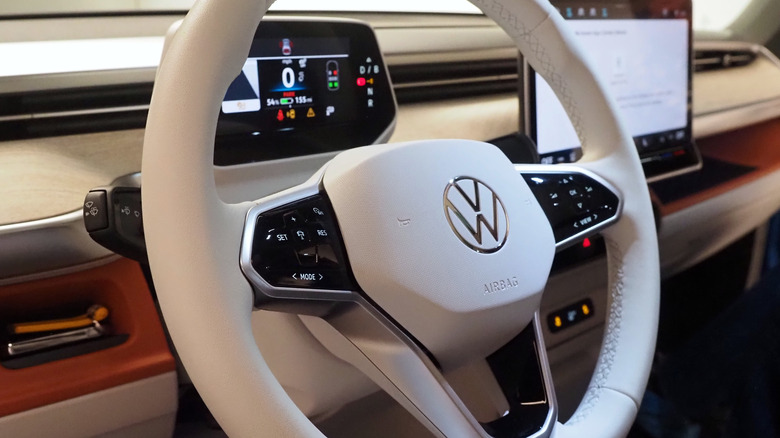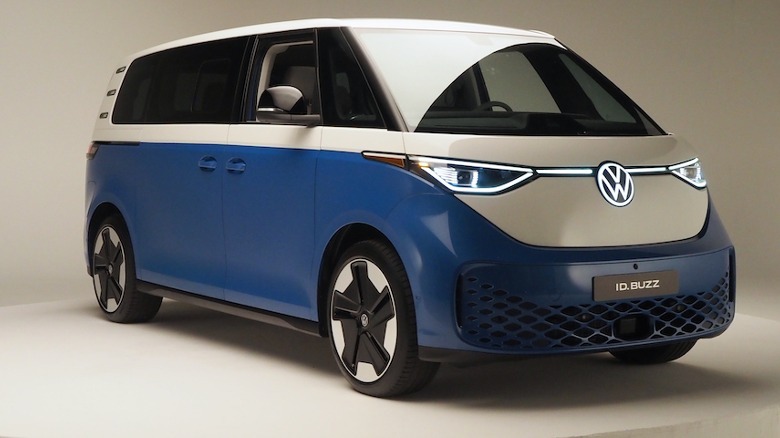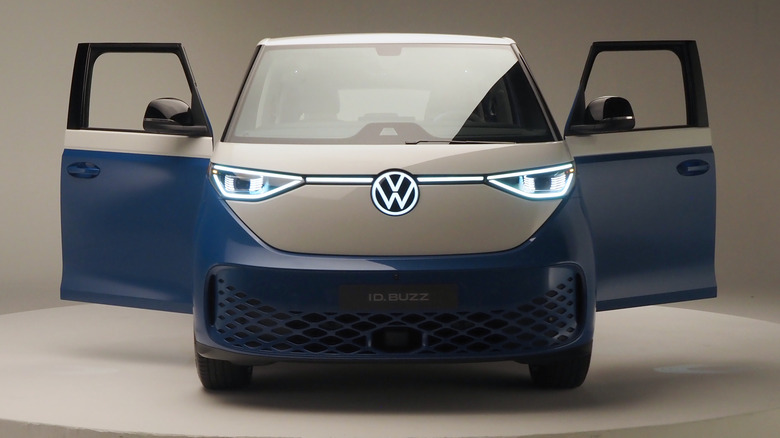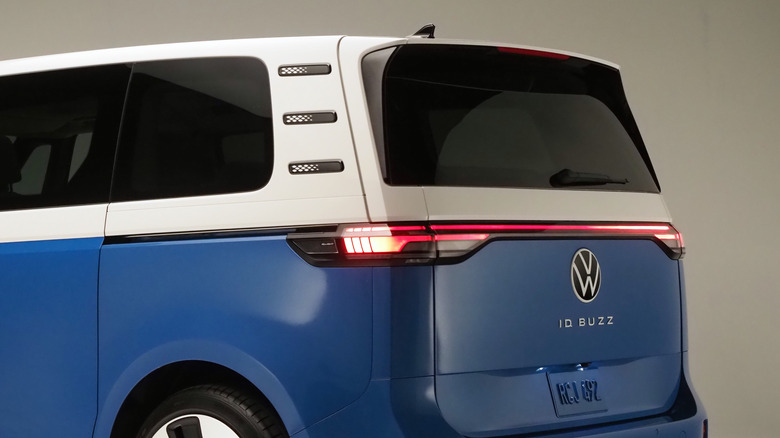Volkswagen's 3-Row ID. Buzz Microbus Is Easy To Fall In Love With At First Look
It feels, frankly, like a very long time since we first saw Volkswagen's electric Microbus. The ID. BUZZ concept of 2016 did exactly what every concept car hopes to achieve: build buzz — pun intended — around an automaker's grand plans for some nebulous point in the future. In this case, taking the classic, beloved VW Microbus, aka the Campervan or just plain Bus, and using it to illustrate the flexibility of Volkswagen's MEB electric platform.
It's fair to say even Volkswagen was surprised by how positive the reception was. The automaker rapidly went from describing the ID. BUZZ as an illustrative concept to a vehicle with production intent, though — wisely and frustratingly — not one to which a specific launch date was attached. Since then, we've seen the launch of the ID.3 in Europe followed by the ID.4 in the U.S. Solid EVs, certainly, but no electric Microbus.
Europe got the first taste of that, with the two-row ID. Buzz launching there in 2022. North American drivers are being asked to show even further patience, with the three-row, long-wheelbase version of the 2025 ID. Buzz not expected to arrive in the U.S. until Q3 2024. Having spent some time up close with the hotly-anticipated EV, it's easy to predict that for many it'll be worth the wait.
More changes than meet the eye
The staggered launch, Pablo Di Si, President and CEO of Volkswagen Group of America told SlashGear in an roundtable interview ahead of today's ID. Buzz debut, is not just because it takes two years to add about 10-inches of extra space to the bus' wheelbase. Instead, the three-row version is distinctively different from its two-row sibling, even if the two look much the same from the outside. Certainly, the longer design — which keeps the short overhangs and chunky proportions — wears its greater length well.
More wheelbase means VW can fit in a bigger battery, which is for the best as the estimated 260 miles of EPA range for the standard rear-wheel drive configuration probably just satisfies the driving expectations of would-be American owners. There'll be an all-wheel drive version, too, with greater traction and potency. What you don't see at first glance is the revamped electrical architecture, now shared with the also-upcoming ID.7 sedan.
That, Di Si says, is a direct response to feedback from ID.4 owners, for whom infotainment headaches have been the biggest point of complaint about their EV. In fact, Volkswagen intentionally hit reset on the three-row ID. Buzz project, so that they could work in the faster, more memory-rich, and re-coded infotainment system. "I'd rather wait one more year and have it right," the Volkswagen chief insists.
It's a minivan, but please don't call it that
Patience is not much of an American virtue, but there's something faintly ironic about quite how eagerly the ID. Buzz is awaited. It is — though Volkswagen doesn't refer to it that way — basically a minivan, hardly the most popular segment in the U.S. recently. Despite all the practicalities that minivans offer, like sliding rear doors, relatively low floors, and plenty of flexible storage space, they just don't have the curb appeal of SUVs.
The 2025 ID. Buzz upends that. Looking at the EV, it's almost as though you're seeing double: you know it's a minivan, sure, but it's also near-impossible not to be charmed by the retro-futuristic aesthetic. Volkswagen has been liberal with those styling cues, from the oversized glowing "VW" badge to the strong, uninterrupted shoulder line for the expansive glasshouse, though they never undermine the electric Microbus' practicality.
A blank canvas for adventure
Americans wouldn't compromise on three rows, Volkswagen's Di Si says, and so the ID. Buzz aims to do plenty with its cabin. The third row seats slide fore and back, and pull out altogether. They're pretty heavy, but there's at least an convenient pull-handle on the back to extract them. Or, you can leave them in place but fold them down flat.
The second row is fixed — Volkswagen says that's because the standard rear motor means the floor at the rear of the EV is slightly higher, so had the middle seats been removable they wouldn't have left a flat floor — though can slide by almost 8-inches fore and aft, and recline. Dropped flat, and with VW's optional Flexboard (which is basically a little shelf unit for the trunk, under which a couple of IKEA-style fabric totes stow), and you could easily slide in a mattress for two. Volkswagen has no current plan for a camper version, Di Si, says, though it's hard not to imagine owners making their own version for impromptu road-trips.
That, perhaps, is the core charm of the ID. Buzz: it encourages experimentation. There's a sense, among a lot of electric vehicles, that they have to be either earnest green transportation or acceleration fiends. Salving, in the process, either our environmental guilt or any lingering appeal for internal combustion sports cars. The electric Microbus, in contrast, simply exists to make you smile: blank canvas meets Choose Your Own Adventure book.
Who gets a spot at the front of the line?
It's not, of course, the first vehicle to package whimsy so conspicuously. The "New" Beetle did the same, as did the PT Cruiser, and a handful of other kooky cars that typically saw vast demand on day one, and then a stark tapering not all that long after. It's a possibility that Volkswagen must face up to, as it tries to balance production, demand, and lingering retro appeal.
With a single factory producing both short- and long-wheelbase versions, Volkswagen is constrained to around 100,000 ID. Buzz units each year. It's not at all difficult to imagine demand far outstripping supply in the U.S. when the EV launches, then, and indeed part of the challenge Di Si and his team is currently immersed in is deciding just how those coveted first examples will be apportioned. The good news is that the Volkswagen of America President is outspoken about disliking dealer price-gouging; the bad news is that he's not entirely sure, just yet, how he's going to prevent it.
"First, I would like to reward people who are loyal to our brand," Di Si says, mentioning the possibility of prioritizing initial ID. Buzz units to existing Volkswagen owners. "At the same time," he adds, "I would like to bring new people into our brand." No surprise, then, that with that tension — and memories of the embarrassing technical glitches impacting both the ID.3 and ID.4 reservations process — the CEO isn't ready to commit either way.
"We need to find a fair way, transparent, for the consumer and for the dealer. That there's no over-pricing, that the system doesn't crash," Di Si explains. "We can do it many different ways, we have another 3-5 months to figure it out."
Avoiding the fate of the New Beetle
Down the line, though, the broader challenge is making sure the ID. Buzz isn't a short-term gimmick. The original Microbus became an icon and a mainstay of Volkswagen's line-up, but the fashion whims of the modern automotive scene are far more intense now. That's another area Di Si hopes some early strategy will pay dividends.
"It's clear to me that, in the next 5 or 6 years, we need to keep the momentum going," he says. "Doing special versions of this is a must. In the lifecycle, it's key to do special versions to survive."
Just what those special versions might consist of is unclear right now. Still, it's not exactly hard to speculate. While a camper is the obvious route, a pet-friendly version of the ID. Buzz also seems like a good idea (hey, it's worked for Subaru). The current model's leatherette seats and rubber-lined bins seem sturdy, but ditching the carpet in favor of something more easily cleaned of mud and dog fur could ramp up the EV's adventure talents.
What price for a halo?
The biggest question, though, is just how much this retro-inspired electric bus will cost. It's a detail Volkswagen isn't ready to share yet, though none of the signs point to the ID. Buzz being a cheap option among EVs. It'll be the automaker's halo car in North America, with a surprisingly high level of standard equipment. "This is not just another launch," Di Si insists, "this is THE launch, for us."
A starting price somewhere around the low to mid-$60k point seems entirely possible, then, if not more. Don't count on the full U.S. EV tax incentive to salve the pain, either, given the ID. Buzz probably won't qualify for the maximum — for outright purchases, at least — because it won't meet the manufacturing requirements.
Again, none of this is likely to dampen demand, but it does mean that for many the dream of an electric Microbus will be out of reach. Volkswagen's hope is that its halo EV will drive interest in its other, more mainstream electric models. Problem is, when you've been thoroughly charmed by the ID. Buzz, it's hard to get quite as excited about anything else.
